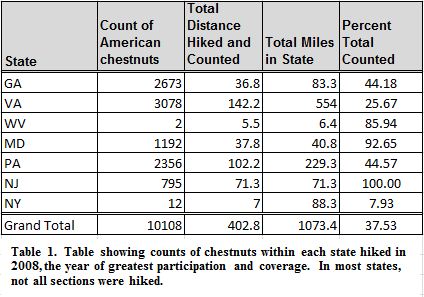
Sara Fitzsimmons is the Regional Science Coordinator at The American Chestnut Foundation
The American Chestnut Foundation (TACF) is a 501(c)(3) organization dedicated to restoring the American chestnut (Castanea dentate) to its original range. Once estimated to be 25% of the Appalachian forests, the species was all but eliminated from the landscape by an imported fungal disease caused by Cryphonectria parasitica, the chestnut blight fungus.
Since 1983, TACF has been working with volunteers and citizen scientists to breed disease-resistant trees and return them to the landscape. The program involves a minimum of six breeding generations, each of which requires labor-intensive controlled pollination to make the seed, and about 5-10 years to grow the trees and properly select them. To work through the entire breeding pipeline, then, takes a large amount of resources, and about 35 – 60 years!
A program such as this would not be possible without the many hands, minds, and legs of citizen scientists. TACF volunteers come from a wide variety of backgrounds – from salesmen to engineers, farmers to doctors and teachers – all of whom can bring a unique perspective to the program and enhance TACF’s work in a multitude of ways.
Over the past 25+ years, 1000s of volunteers have bred various generations of trees and grown tens of thousands of trees on their land. While breeding is the backbone of TACFs work, and there is continued need for more growers, citizen scientists have not only participated in, but also initiated, some unique programs.

One of those programs involves another larger citizen-science based program called the Appalachian Trail Mega-Transect. As part of this project, hikers are trained each spring on standard data collection practices and on how to properly identify American chestnuts along the trail. Since 2008, the data collection procedure has been refined, and interesting trends in data along the trail have been captured (Table I). We continue to expand areas hiked, and also re-hike sections as the data collection standards are refined.
TACF’s Maryland Chapter has been integral in creating and enhancing the TACF Chestnut Learning Box. Created by a former lawyer and teacher, as well as a retired physicist, the learning box uses biological artifacts such as chestnut burs, canker pieces, and wood samples to teach not only about chestnut and its fight with a fungal disease, but also about larger forest sustainability issues.
These are just two examples of the monitoring, growing, education, outreach, and similar projects underway for TACF’s citizen scientists. I invite you to learn more about TACF and how you can help us restore the American chestnut. My contact information is below.
Sara Fern Fitzsimmons
The Pennsylvania State University
206 Forest Resources Lab
University Park, PA 16802
e-mail: sara@acf.org
phone: 814-863-7192


